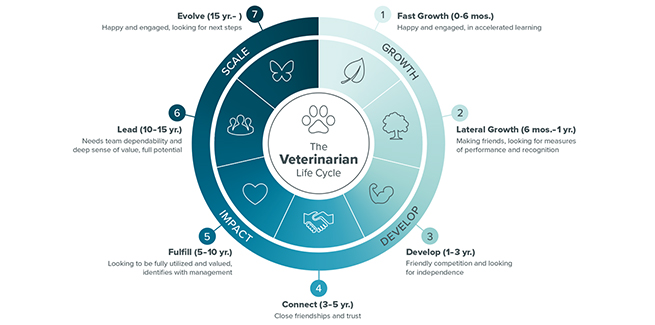Like pets, veterinarians go through discrete life stages during their careers

“That first year’s disheartening for many of us,” Jessica Vogelsang, DVM, told NEWStat about starting out in the veterinary profession. “It really is. But the worst part is, it doesn’t end there.”
Vogelsang, who graduated from veterinary school in 2002, speaks from personal experience. And a 2020 study of career satisfaction sponsored by Merck bears her out.
Researchers interviewed 2000 veterinary team members asking them how they felt about their jobs. Were they engaged in their work? Did they have job satisfaction? And if not, why not?
When Vogelsang read the results—which were separated by how long respondents had been working in the profession—she noticed something interesting: “It was almost like reading about life stages for pets.”
The survey revealed that there are distinct patterns in job satisfaction and engagement that are relative to how long people have been in the profession.
For Vogelsang, one finding in particular jumped out at her: “Engagement and satisfaction is at its highest on the first day of your job—and immediately plummets,” she said. “And it continues to plummet for three to five years.”
Vogelsang said she “strongly identified” with that feeling of bottoming out after her first five years, and questioning whether or not she made the right career choice. She said it helped to know after reading the study that it wasn’t just her, that the feelings were universal.
And it’s not just young people: the study sheds light on why veterinarians at every stage of their career choose to leave the profession. It’s not because they don’t want to be veterinarians—the desire to be a part of the profession never really goes away. What does dwindle, however, is the feeling that their skills are being given the chance to shine.
Vogelsang said it doesn’t have to be that way. “The profession needs to start by acknowledging that it’s happening in the first place. And to let people know that it does get better.” Because after five years, the findings say, things start to improve. Whether it’s finally finding the right footing or surrounding themselves with the right people, something changes for veterinarians at that critical time.
To get the conversation started, AAHA will present the findings and their implications for the future of the profession in a frank, free, and far-reaching interactive panel discussion on August 10th at 4 p.m. PT. Vogelsang will moderate a panel featuring new graduate Kristi Crow, DVM, consultant Danielle Lambert, and veterinarian, mother, and entrepreneur Julie Buzby, DVM.
The webinar will address the question of how to keep these vets in the field, how practices can do a better job serving associates’ needs, and how individuals can empower themselves to find the right fit from the start.
Vogelsang said that in addition to finding opportunities that play to ones’ strengths, the study indicates that engagement also boils down to a question of community: “Your relationships with your coworkers, and feeling supported by them, are often the most important thing that determines whether or not you’re happy at work.”
This all ties into work AAHA has previously done to identify and promote the actions that make for a healthy workplace culture, said Vogelsang: “It’s a set of values, a set of beliefs, and how they translate into behaviors that create a positive work environment.”
“The people around you have a direct impact on your engagement and satisfaction, and so it’s worth it to invest in those tools and behaviors to create a healthy workplace because that will have a direct impact on whether or not your employees want to stay,” she added.
“We know from this study that what people one to five years out of school need most is the support of their colleagues and the opportunity to develop their individual strengths, their own unique skill sets.”
Vogelsang said the practices that offer those opportunities and build them into their culture are the practices that will be in the best position to recruit and retain younger talent. In other words, “Practices that acknowledge that each individual’s goals are key to the success of the practice as a whole.”
Vogelsang said the goal of the webinar is to reach people who are in that one to five year range. “However, we encourage everybody, especially owners and managers, to listen to the discussion because it may help them recognize the mindset of people who are newer and realize that there things they should be doing in their practices to make it more attractive so they can attract and retain new talent.”
Vogelsang said the panelists identified strongly with the study’s findings, whether they had been in the field for one year or 25: “We lived this and we came through on the other side, still engaged, and we want people to know that. We’d love for young veterinarians to find a clinic that’s a great match for them.”
But the study acknowledges that not every veterinarian is suited to working in a hospital, and Vogelsang herself is a great example—she departed clinical practice in 2015 after investing years in building a career as a writer. She found her niche as a best-selling author, public speaker, and in her most recent incarnation as Veterinary Content Strategist for AAHA.
As Vogelsang notes, “There are other ways to be successful with this degree.”
Join Vogelsang and three other female veterinarians for “Entrepreneurship, empowerment, and personal branding: How to fight burnout in the first 5 years,” a special free interactive webinar on August 10 at 4 p.m. Pacific Time. You’ll hear real talk from women who aren’t afraid to dig deep, open up, and ask questions. Register now.



